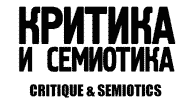Search
| # | Search | Downloads | ||||
|---|---|---|---|---|---|---|
| 1 | The introduction to the article presents the context in which data from a series of pedagogical experiments was generalized. This context consisted of the characteristics of “forced symbolism” and the rupture of “subject-to-subject” communication. Both characteristics were the result of applying the concept of “semiotic diagnostics” (Irina V. Melik-Gaikazyan). The next section of the article, “Visual Arguments for Setting the Research Problem,” discusses the concept of “visual literacy” (John L. Debes) and analyzes the visual representations of primary school students (grades 1–4) and 5th-graders based on their drawings. Collages made from these drawings are presented (“Filimonovskaya Toy,” “Dove of Peace,” “Motherhood,” “Gzhel”). It is concluded that, firstly, by grade 5, children studying in regular schools lose interest in drawing. Secondly, in the 5th grade, children independently master digital methods of combining and/or reduplicating visual samples, which specifically demonstrates the effect of “forced symbolism.” The “Materials and Methods” section provides characteristics of the series of pedagogical experiments. The experiment participants were 5th grade students. A set of symbols in a specific school textbook became the object of the study, and the nature of decoding navigation signs became irs focus. The series consisted of two stages of a didactic experiment; a creative experiment (the name of this experiment records the manifestation of students’ creative abilities); two stages of a verification experiment. By groups of participants, the series of experiments is divided into didactic and creative experiments, in which participants from a specific school took part, and a verification experiment, in which schoolchildren from other schools took part. The stages of the didactic and verification experiments are similar in methods. At the first stage, schoolchildren were offered open-ended questions, and at the second stage, closed-ended questions with answer options. The questions were aimed at establishing the possibility of decoding navigation signs in a specific Russian language textbook (published by Mektep). Out of ten navigation signs, four signs were not decoded during the didactic experiment (“Listen,” “Speak,” “Learn the theory,” and “Work with the word”). In the creative experiment, children were asked to create a visual sign about these educational activities themselves. The content of the “Research Results” section consisted of, firstly, navigation signs for four educational activities developed by the authors (based on the visualized ideas of students); secondly, a generalization of the verification experiment results (the new signs “Listen” and “Speak” acquired didactic efficiency, and the new signs “Learn the theory” and “Work with the word” did not, since the students did not understand the content of the formulations for these educational activities). A comparison of experimental data with theoretical results of visual semiotics achieved in recent years served for a number of conclusions. The semiotic diagnostics of symbols in a specific textbook helps to identify the need to modify the formulations of naming educational activities. This circumstance demonstrates the potential of visual semiotics, which allows us to draw conclusions about the didactic effectiveness of the entire textbook based on the corresponding diagnostics of its visualized part. It was established that, firstly, the involvement of schoolchildren, implemented in the course of a creative experiment, in the modification of navigation signs serves to identify those problem areas that require methodological reflection. Secondly, this involvement becomes a way to clarify schoolchildren’s visualized ideas, which serves both to determine the directions of the formation of types of visual literacy and to respond to changing social requirements for educational results. The need for a new scientific and practical direction is established: didactic visual semiotics. Keywords: types of visual literacy, symbols in school textbooks, didactic efficiency, methodological reflection, didactic visual semiotics | 191 | ||||










